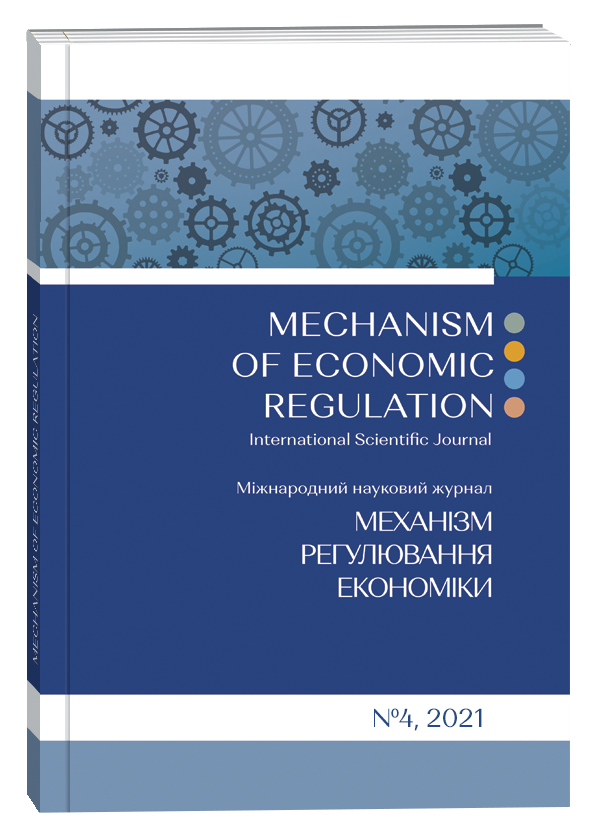ДИНАМІКА ОБСЯГУ ПОДАТКОВИХ НАДХОДЖЕНЬ В УКРАЇНІ У ПЕРІОД КРИЗИ
Анотація
В статті досліджено динаміку обсягу податкових надходжень у бюджет України в умовах кризи. За допомогою R|S аналізу визначено, що динаміка податкових надходжень (у щомісячному розрізі) до Зведеного бюджету України у період 2011−2021 рр. є антиперсистетною, фракталоподібною і не піддається методам прогнозування на основі параметричних залежностей, простих та комплексних трендів. Досліджено форму розподілу щільності ймовірності обсягу податкових надходжень, визначено їх ентропію та виробництво ентропії. Встановлено, що найбільш кризовими періодами у формуванні податкових надходжень є 2019−2020 рр., за окремими видами податків − 2016−2020 рр. Розроблено дві системи класифікації податків: за рівнем фракталоподібності динаміки обсягу податкових надходжень та за особливостями динаміки ентропії та виробництва ентропії, на основі яких сформовано типологію податків з дев’яти типів. В Україні таких типів податків виявлено п’ять. Встановлено, що виходячи із особливостей динаміки ентропії та виробництва ентропії, найбільш дієвими для подолання кризи будуть податкові інструменти, пов’язані із справлянням податку на прибуток, податку на додану вартість на товари, вироблені в Україні, рентної плати та рентної плати за користування надрами. На нашу думку, для інших видів податків та зборів суттєві зміни податкового механізму є недоцільними.
Посилання
Методика прогнозування надходжень від податку на додану вартість: затверджена Наказом міністерства фінансів України № 545 від 31. 08. 2004 р., Наказом Міністерства економіки та з питань європейської інтеграції України № 315 від 31. 08. 2004 р., Наказом Державної податкової адміністрації України № 502 від 31. 08. 2004 р., Наказом Державної митної служби України № 637 від 31. 08. 2004 р. URL: https://zakon.rada.gov.ua/laws/show/z1202-04#Text.
Козоріз Л. Аналіз методик прогнозування основних бюджетоутворюючих податків. Київ: Офіс з фінансового та економічного аналізу у Верховній Раді України. 2018. 20 с. URL: https://feao.org.ua/wp-content/uploads/2018/10/2018-10-23-analysis-of-theforecasting-methodology-of-main-budget-forming-taxes.pdf.
Вдовиченко А. М., Зубрицький А. І., Орос Г. В. Сучасний світовий досвід розробки і впровадження методик прогнозування доходів державного бюджету. Ірпінь: НДІ фінансового права, 2014. 58 с. URL: http://ndi-fp.nusta.com.ua/files.
Reinmuth J. E., Geurts M. D. (1979) “A multideterministic approach to forecasting”. IMS Studies in the Management Science. 1979. Vol. 12. Р. 203-211. URL: https://www.econbiz.de/Record/a-multideterministic-approach-to-forecasting-reinmuthjames/10002679545.
Beckett-Camarata J. (2006) “Revenue Forecasting Accuracy in Ohio Local Government”. Journal of Public Budgeting, Accounting & Financial Management. Vol. 18(1). Р. 77-99. URL: https://www.emerald.com/insight/content/doi/10.1108/JPBAFM-18-01-2006B004/full/html.
Challenges in Forecasting Tax Revenue. International monetary fund. URL: https://www.imf.org/en/Publications/SPROLLs/covid19-special-notes.
Sabaj E. and Kahveci M. (2018) “Forecasting tax revenues in an emerging economy: The case of Albania”. University of Exeter, Istanbul University. 34 p. URL: https://mpra.ub.uni-muenchen.de/84404/1/MPRA_paper_84404.pdf.
Martynenko V. (2019) “Scenario approach in forecasting tax revenues of the state budget of Ukraine”. Economics. Ecology. Socium. Vol. 3 № 3. Р. 27-34.URL: https://eesjournal.com/index.php/journal/article/view/110.
Streimikiene D., Rizwan R . A., Vveinhardt J., Ghauri S. P. and Sarwar Z. (2018) “Forecasting tax revenues using time series techniques – a case of Pakistan”. Economic Research. Vol. 31. URL: https://www.tandfonline.com/doi/full/10.1080/1331677X.2018.1442236.
Molaro A. M., Ama N. O. and Olaomi J. (2019). “Bayesian Vector Auto-Regression Method as an Alternative Technique for Forecasting South African Tax Revenue”. Southern African Business Review. Vol. 23. 28 p. URL: https://www.ajol.info › sabr › article › view.
Groves H. M. and Kahn C. H. (1952) “The stability of state and local tax yields,” The American Economic Review. Vol. 42 (1), P. 87-102. URL: https://www.jstor.org/stable/1914417.
Dye R. F. and McGuire T. J. (1991) “Growth and variability of state individual income and general sales taxes”. National Tax Journal. Vol. 44 (1). P. 55-66. URL: https://www.journals.uchicago.edu/doi/abs/10.1086/NTJ41788877?journalCode=ntj.
Sobel R. S. and Holcombe R. G. (1996) “The Impact of State Rainy Day Funds in Easing State Fiscal Crises During the 1990–1991 Recession”. Public Budgeting & Finance. Vol. 16 (3), P. 28-48. URL: https://papers.ssrn.com/sol3/papers.cfm?abstract_id=465670.
Bruce D., Fox W. F. and Tuttle M. H. (2006) “Tax Base Elasticities: A Multi-State Analysis of Long-Run and Short-Run Dynamics”. Southern Economic Journal. Vol. 73 (2), P. 315-341. URL: https://www.jstor.org/stable/20111894.
Giertz J. F. (2006) “The property tax bound”. National Tax Journal. Vol. 59 (3). P. 695– 705. URL: https://www.jstor.org/stable/41790350
Seegert N. (2018) “Optimal Tax Policy Under Uncertainty Over Tax Revenues”. Department of Finance, University of Utah. 49 p. URL: https://ntanet.org/wpcontent/uploads/2019/03/Session1208_Paper1990_FullPaper_1.pdf.
Mandelbrot B. B. Fractals: Form, Chance, and Dimension. San Francisco. W. H. Freeman and Company. 1977. 352 p. URL: https://www.worldcat.org/title/fractals-form-chanceand-dimension/oclc/3154119.
Гачков А. А. Рандоминизированный алгоритм R/S-анализа финансовых рядов. Стохастическая оптимизация в информатике. Сб. науч. трудов. С.-Петербург, 2009. Вып. 5. С. 40-64. URL: https://www.math.spbu.ru/user/gran/soi5/Gatchkov5.pdf.
Хайтун С. Д. От эргодической гипотезы к фрактальной картине мира. Рождение и осмысление новой парадигмы/ С. Д. Хайтун. − М.: Комкнига, 2007. − 256 с. URL: https://ua1lib.org/book/3285814/424590?id=3285814&secret=424590.
Державні фінанси. Національний банк України. URL: https://bank.gov.ua/ua/statistic/macro-indicators#4.
Савіцька С. І., Фугело П. М. Аналіз впливу пандемії корона вірусу на надходження до державного бюджету України. Modern Economics. 2020. № 21. С. 187-191. URL: https://modecon.mnau.edu.ua/issue/21-2020/savitska.pdf.
Макроекономічна статистика. Статистична інформація. URL: http://www.ukrstat.gov.ua.
Проблеми і перспективи зміцнення стійкості фінансової системи України: Аналітична доповідь. Київ: Національний інститут стратегічних досліджень. 2020. 71 с. URL: https://niss.gov.ua/sites/default/files/2020-11/dopovid-fin-stiykist-1.pdf.
Eugene N. and Chineze E. A. (2015). “Productivity of the Nigerian tax system (1994– 2013)”. International Journal of Business Administration. Vol. 6, P. 30–40. URL: https://www.sciedu.ca/journal/index.php/ijba/article/view/7377.
Methodology for forecasting value added tax revenues: approved by the Order of the Ministry of Finance of Ukraine № 545 of 31.08.2004, the Order of the Ministry of Economy and European Integration of Ukraine № 315 of 31.08.2004, the Order of the State Tax Administration Of Ukraine № 502 dated 31.08.2004, the Order of State Customs Service of Ukraine № 637 dated 31.08.2004. URL: https://zakon.rada.gov.ua/laws/show/z1202-04#Text.
Kozoriz L. (2018) “Analysis of methods for forecasting the main budget-generating taxes”. Kyiv: Office for Financial and Economic Analysis in the Verkhovna Rada of Ukraine. URL: https://feao.org.ua/wp-content/uploads/2018/10/2018-10-23-analysis-of-the-forecastingmethodology-of-main-budget-forming-taxes.pdf.
Vdovychenko A. M., Zubrytskyi A. I. and Oros H. V. (2014) “Modern world experience in the development and implementation of methods for forecasting state budget revenues”. Irpen: Research Institute of Financial Law. 58 p. URL: http://ndi-fp.nusta.com.ua/files.
Reinmuth J. E., Geurts M. D. (1979) “A multideterministic approach to forecasting”. IMS Studies in the Management Science. 1979. Vol. 12. Р. 203-211. URL: https://www.econbiz.de/Record/amultideterministic-approach-to-forecasting-reinmuth-james/10002679545.
Beckett-Camarata J. (2006) “Revenue Forecasting Accuracy in Ohio Local Government”. Journal of Public Budgeting, Accounting & Financial Management. Vol. 18(1). Р. 77-99. URL: https://www.emerald.com/insight/content/doi/10.1108/JPBAFM-18-01-2006-B004/full/html.
Challenges in Forecasting Tax Revenue. International monetary fund. URL: https://www.imf.org› Files › covid19-special-notes.
Sabaj E. and Kahveci M. (2018) “Forecasting tax revenues in an emerging economy: The case of Albania”. University of Exeter, Istanbul University. 34 p. URL: https://mpra.ub.unimuenchen.de/84404/1/MPRA_paper_84404.pdf.
Martynenko V. (2019) “Scenario approach in forecasting tax revenues of the state budget of Ukraine”. Economics. Ecology. Socium. Vol. 3 № 3. Р. 27-34.URL: https://eesjournal.com/index.php/journal/article/view/110 .
Streimikiene D., Rizwan R . A., Vveinhardt J., Ghauri S. P. and Sarwar Z. (2018) “Forecasting tax revenues using time series techniques – a case of Pakistan”. Economic Research. Vol. 31. URL: https://www.tandfonline.com/doi/full/10.1080/1331677X.2018.1442236.
Molaro A. M., Ama N. O. and Olaomi J. (2019). “Bayesian Vector Auto-Regression Method as an Alternative Technique for Forecasting South African Tax Revenue”. Southern African Business Review. Vol. 23. 28 p. URL: https://www.ajol.info › sabr › article › view.
Groves H. M. and Kahn C. H. (1952) “The stability of state and local tax yields,” The American Economic Review. Vol. 42 (1), P. 87-102. URL: https://www.jstor.org/stable/1914417.
Dye R. F. and McGuire T. J. (1991) “Growth and variability of state individual income and general sales taxes”. National Tax Journal. Vol. 44 (1). P. 55-66. URL: https://www.journals.uchicago.edu/doi/abs/10.1086/NTJ41788877?journalCode=ntj.
Sobel R. S. and Holcombe R. G. (1996) “The Impact of State Rainy Day Funds in Easing State Fiscal Crises During the 1990–1991 Recession”. Public Budgeting & Finance. Vol. 16 (3), P. 28-48. URL: https://papers.ssrn.com/sol3/papers.cfm?abstract_id=465670
Bruce D., Fox W. F. and Tuttle M. H. (2006) “Tax Base Elasticities: A Multi-State Analysis of Long-Run and Short-Run Dynamics”. Southern Economic Journal. Vol. 73 (2), P. 315-341. URL: https://www.jstor.org/stable/20111894.
Giertz J. F. (2006) “The property tax bound”. National Tax Journal. Vol. 59 (3). P. 695–705. URL: https://www.jstor.org/stable/41790350
Seegert N. (2018) “Optimal Tax Policy Under Uncertainty Over Tax Revenues”. Department of Finance, University of Utah. 49 p. URL: https://ntanet.org/wpcontent/uploads/2019/03/Session1208_Paper1990_FullPaper_1.pdf.
Mandelbrot B. B. (1977) “Fractals: Form, Chance, and Dimension”. San Francisco. W. H. Freeman and Company. 352 p. URL: https://www.worldcat.org/title/fractals-form-chance-anddimension/oclc/3154119.
Gachkov A. A. (2009) “Randomized algorithm for R / S analysis of financial series”. Stochastic optimization in computer science. Vol. 5. P. 40-64. URL: https://www.math.spbu.ru/user/gran/soi5/Gatchkov5.pdf.
Khaitun S. D. (2007) “From an ergodic hypothesis to a fractal picture of the world. Birth and comprehension of a new paradigm”. Moscow, Komkniga. 256 p. URL: https://ua1lib.org/book/3285814/424590?id=3285814&secret=424590.
State finance. NBU. URL: https://bank.gov.ua/ua/statistic/macro-indicators#4.
Savitska S. I., Fuhelo P. M. (2020) “Analysis of the impact of the Crown virus pandemic on revenues to the state budget of Ukraine”. Modern Economics. № 21. С. 187-191. URL: https://modecon.mnau.edu.ua/issue/21-2020/savitska.pdf.
Macroeconomic statistics. Statistical information. URL: http://www.ukrstat.gov.ua/.
Problems and prospects for strengthening the stability of the financial system of Ukraine: Analytical report. Kiev: National Institute for Strategic Studies. 2020. 71 p. URL: https://niss.gov.ua/sites/default/files/2020-11/dopovid-fin-stiykist-1.pdf.
Eugene N. and Chineze E. A. (2015). “Productivity of the Nigerian tax system (1994–2013)”. International Journal of Business Administration. Vol. 6, P. 30–40. URL: https://www.sciedu.ca/journal/index.php/ijba/article/view/7377.


